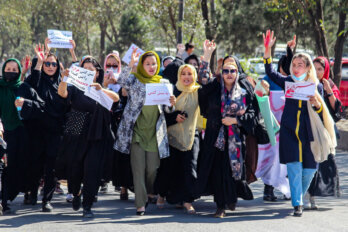The taxi twists and turns through the cobblestone lanes of Havana’s old town. I can barely see the road out in front as I sink deeper into the black leather seat, soft and worn from decades of passengers.
“Año? ” I ask, tapping the dash.
“Cincuenta y siete,” the driver says. He rubs the spot on the dash where I just touched as if he’s wiping away a greasy fingerprint. With a few more turns of his maroon beast—a ’57 Chevy coupe—we’re out onto the Malecon, the eight-kilometre causeway that separates city from sea. The air is warm, salty. The car shudders as we gain speed. He presses a button on the radio: definitely not the Buena Vista Social Club. We pass an immaculate pink-and-white Ford, a blue Studebaker, then a red Buick convertible—all from the ’50s. The cars are as iconic to Cuba as a portrait of Che Guevara or a bust of José Martí. They are the country’s past, relics of its pre-revolution, pre-economic embargo history, maintained and restored out of necessity rather than desire. But these cars also represent Cuba’s future, and the change that those off the island have been expecting for decades.
The widely held presumption is that the Cuba we have known for a half-century will vanish once the US economic embargo falls. That feels finally on the horizon, with Barack Obama calling for “serious debate about lifting the embargo” late last year. Cuba could be opened for the first time since 1960. The classic cars will be bought off and replaced with modern ones. The colonial buildings will be torn down to make way for new development and hotels. The charm that has been preserved—whether intentionally or circumstantially—will fade.
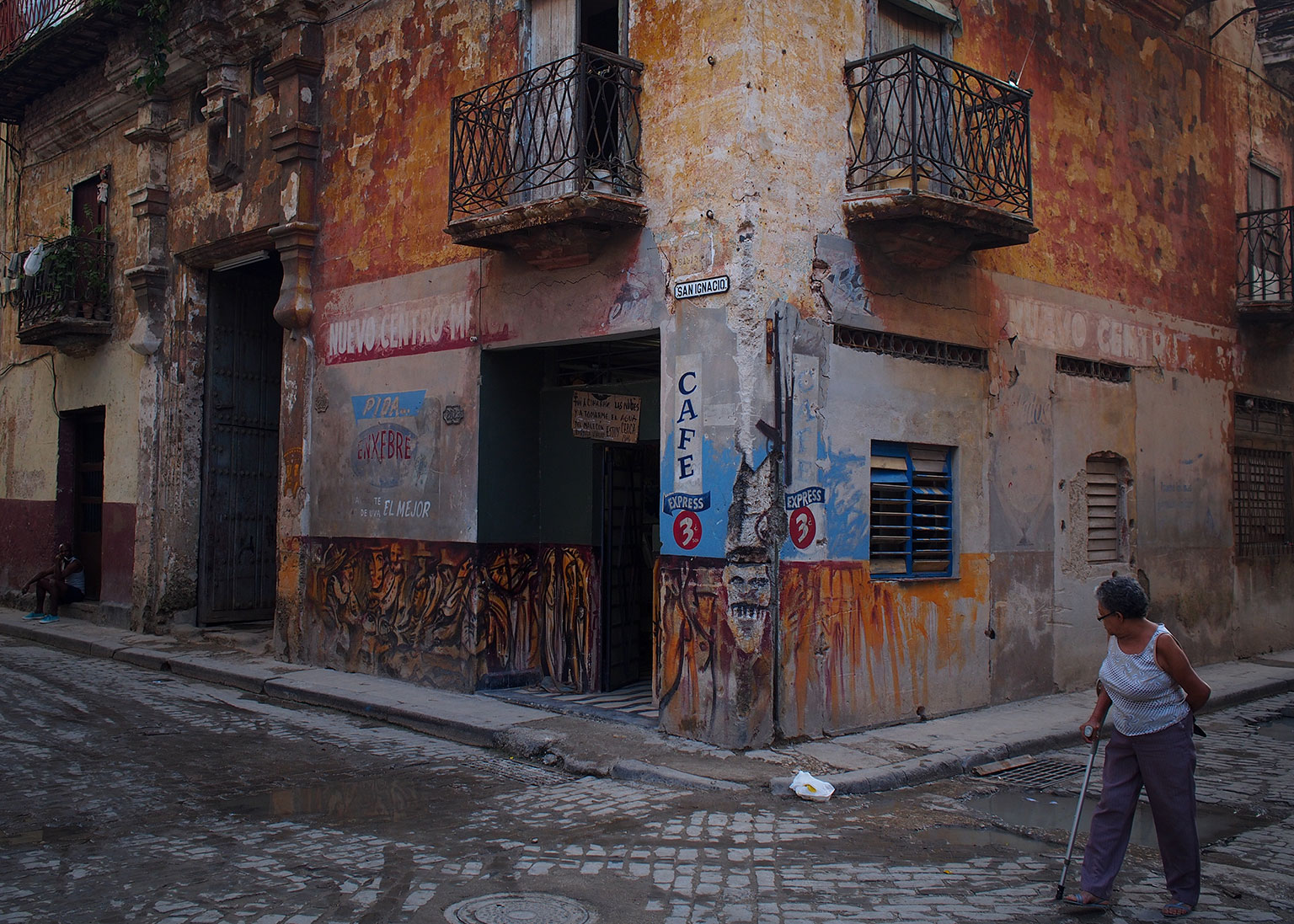 Havana’s old town has a privately owned café or restaurant around every corner.
Havana’s old town has a privately owned café or restaurant around every corner.The taxi turns south off the Malecon, into the grid of Habana Centro, as the driver looks for my accommodation. The streets are rutted and the buildings scruffy, but crisp Cuban flags fly everywhere—draped out windows, dangling from a line across the street, hanging in shop windows. It’s nearly New Years—also Dia de la Liberacion, when the country celebrates Fidel Castro and his revolutionaries’ January 1, 1959 ouster of US-backed president Fulgencio Batista.
The driver drops me outside a blue door, where I’ve booked a room in a second-story colonial apartment. I ring the buzzer and a woman in her fifties opens up and welcomes me inside. Four years ago, Raul Castro, who took over the presidency from his ailing brother in 2008, introduced economic reforms that loosened regulations on private enterprise. Dozens of professions, including taxi driver and shop owner, were dropped from government control. Between 2000 and 2010, the number of self-employed Cubans held steady at around 150,000. Over the past four years of more open entrepreneurship, that number has soared to nearly half a million. For Cubans working in tourism, this meant owning a casa particular (i.e., renting rooms in your house or apartment to tourists) or a paladar (i.e., running a private restaurant) became easier and more profitable.
While the number of tourists in Cuba has steadily increased since 2009, the changes in regulations for entrepreneurs have created an economic climate where those who work in tourism are earning vastly more than those who do not. The latter are being left behind.
“We make more now,” says Antonio, my casa owner. (All names of Cuban citizens have been changed.) It’s the next morning. We’re sitting in the common living room, sipping coffee on couches covered in floral-patterned blankets. “The money is very important for my family. When we started, only a few [casas particulares]. But now there are hundreds in Havana. If [we are] full, I go to my neighbour.” He points out the window at two tourists sitting on a balcony across the street.
Antonio and his wife, Maria, renovated their apartment in 2012, building two bedrooms with attached bathrooms, and affixing the blue-and-white casa particular sign next to the buzzer at their front door. Within weeks, they were changing sheets, cooking breakfast, and watching their income grow exponentially.
A Cuban working a state job—including farmer, construction worker, and salesperson—earns around $25 per month. Antonio and Maria charge that much for one night’s stay in their casa. They will also cook you breakfast for an additional $4, or dinner for $7. Their monthly income is not just double or triple, or even five times more than the tobacco farmer in the countryside, as would be the case in several other countries around the world with strong tourist economies; it’s actually fifty to a hundred times more. In the 1950s, this kind of economic disparity was one of the driving forces that spurred revolution, when a small percentage of the Cuban population controlled the majority of the wealth.
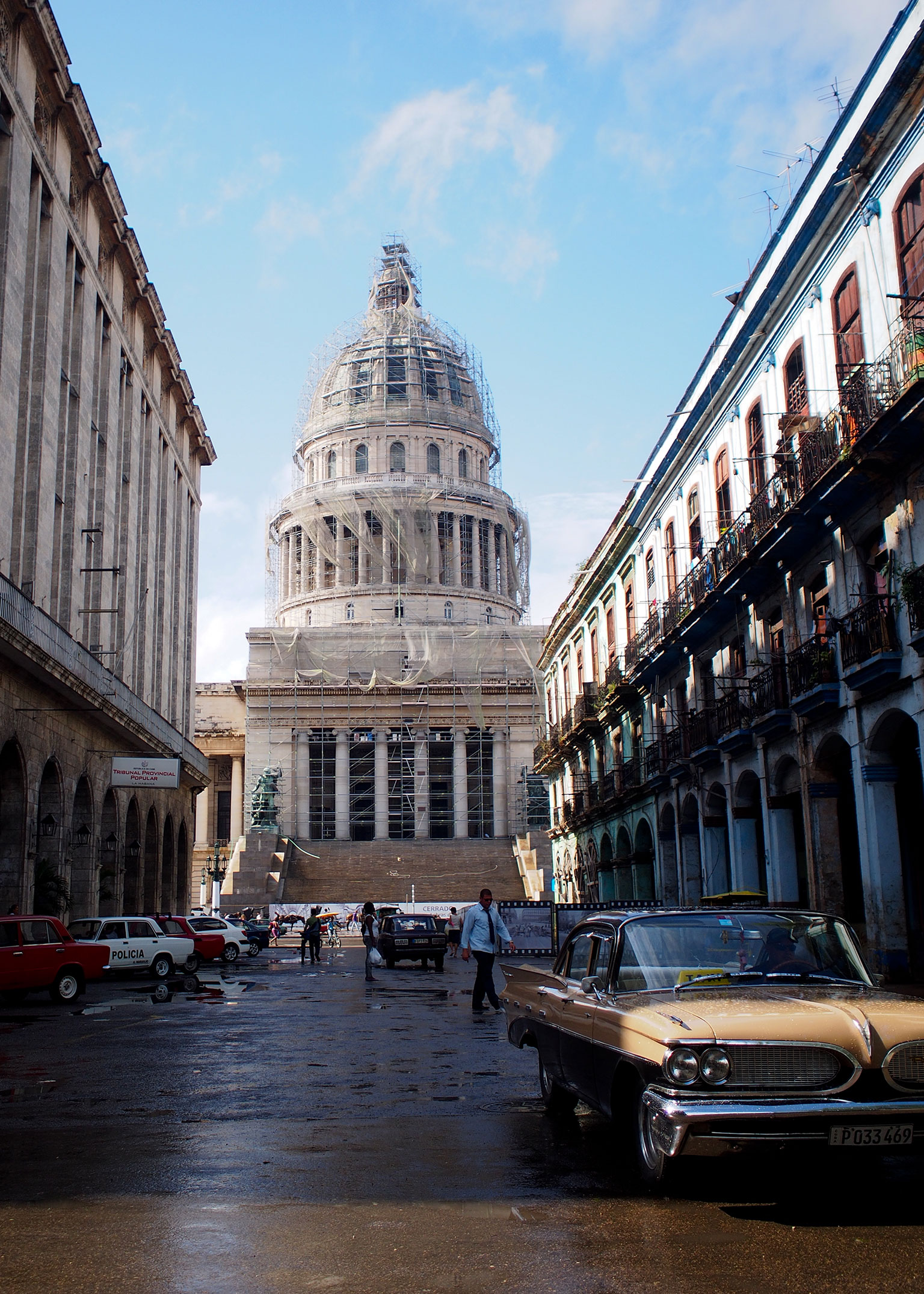 Now housing Cuba’s Ministry of Science, Technology, and the Environment, El Capitolio is being restored to seat the National Assembly.
Now housing Cuba’s Ministry of Science, Technology, and the Environment, El Capitolio is being restored to seat the National Assembly.I take a walk through Habana Centro towards El Capitolio—Cuba’s National Capitol Building that’s more than a little reminiscent of the US version in Washington, DC. There’s pride in the streets—and, perhaps more so than ever, optimism—days after Barack Obama and Raul Castro held simultaneous press conferences with pledges to reopen dialogue, reassess the embargo, and gradually remove travel restrictions.
Out of the 2.8 million tourists who visited Cuba in 2013, a full third were Canadian, while only approximately 98,000 were American. For each decade that Cuba has remained off limits to Americans, the island’s allure has only grown. As restrictions ease further, US tourists will undoubtedly flock in record numbers, bringing more CUCs (convertible pesos, the currency used predominantly by tourists to pay for accommodations, meals, tickets, and souvenirs) to the pockets of some.
I meet Ramon, a professor at the University of Habana, in leafy Parque Central one morning. He walks up and asks what I am reading in the Granma—the state-run newspaper named after the yacht Castro and company sailed from Mexico to Cuba in 1956. I’m not reading, rather picking out the odd word with my limited Spanish. He asks my job, and then launches into telling me his thoughts on the future of Cuban-US relations.
When I watched Raul on the television, I was very anxious. After he said that they will start a discussion with the Americans, I was shocked, surprised. Tremendously happy. We are so close. We should be neighbours. We should be partners. But there is so much tension . . . Before, many Americans came to Cuba. It was a favourite holiday for them. I hope they come back.
Born in Havana, Ramon has watched his city change for more than sixty years. On the surface, his country appears locked in a time warp, but underneath the people are starting to feel different to him. He’s positive about the change, but he’s hesitant too: “I’m worried because for many many decades Americans looked at Cuba as part of America,” he says. “We are so close and they may still want it.”
I ask Ramon what he expects for Cuba’s future. He says changes will come, as more tourist dollars flow in. He looks down the Paseo del Prado, the boulevard that divides the restored Habana Vieja and the ungroomed Habana Centro, pointing to the Hotel Inglaterra with its twenty-four, near-identical balconies that overlook the park. “Every room in Havana: full.”
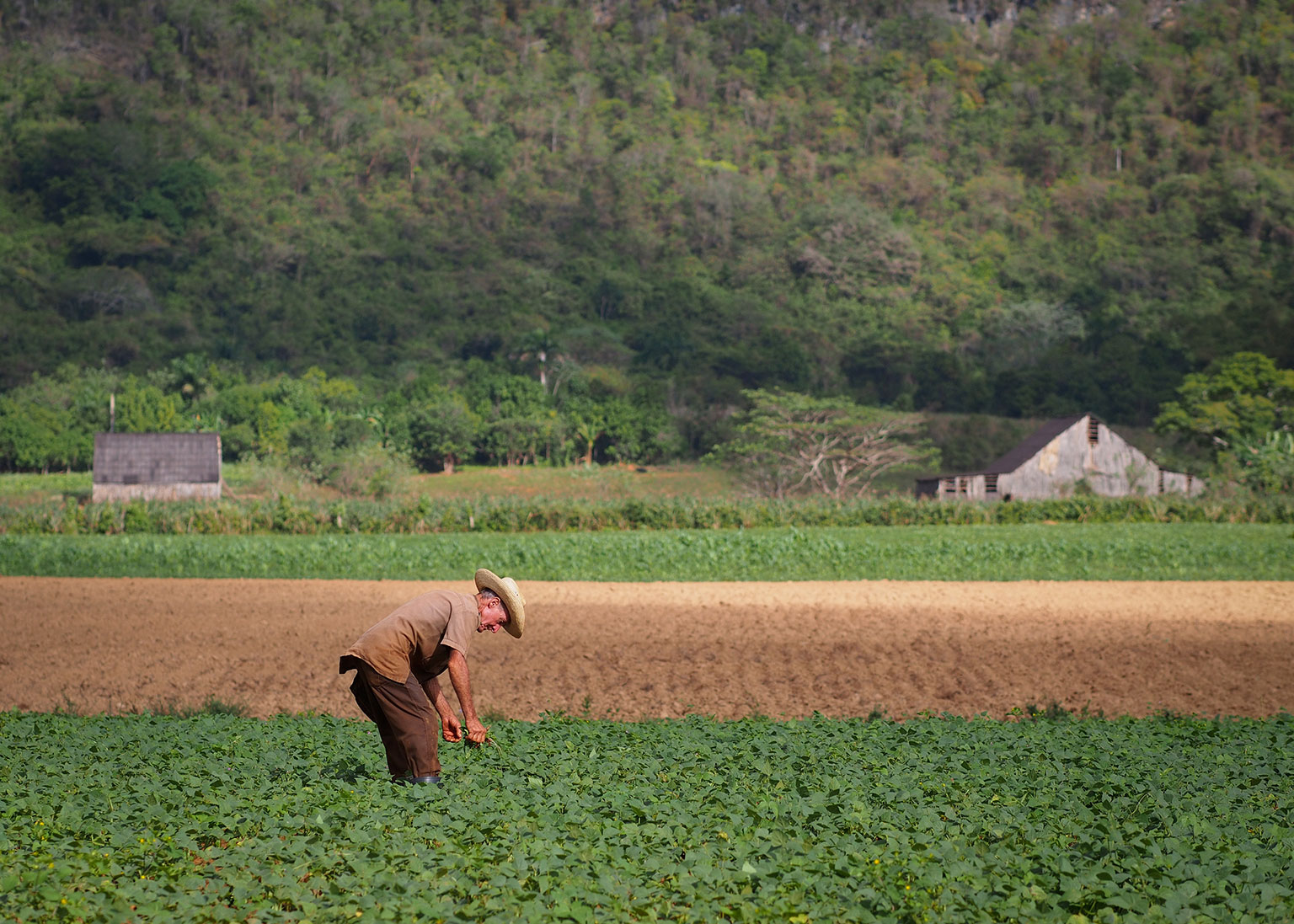 Five months after the revolution, Castro’s government passed the Agrarian Reform Law, which limited the size of farms and redistributed larger plots.
Five months after the revolution, Castro’s government passed the Agrarian Reform Law, which limited the size of farms and redistributed larger plots.By bus, it is less than half an hour from downtown Havana to farmland. The city ends; fields and forest takes over. After two more hours west, my bus drops me in Viñales—a leafy town surrounded by craggy karst hills called mogotes. The region is the epicentre of Cuba’s tobacco industry, with the finest leaves picked from the fincas (farms) of the island’s most westerly province.
The moment I step down from the bus, I am confronted by a half-dozen women shoving business cards in my face. After a furious scrum, each one breaks off to trot beside tourists down the street, extolling the virtues of her family’s casa particular. I head down a side street to see if I can spot a blue-and-white sign on my own. It’s the extreme high season, but my fears of having to hunt for a free room vanish when I notice that nearly every house in town offers tourist accommodations. The town now offers an estimated 400 casas particulares—exponentially more than only a few years ago.
I find one easily, tucked down a side street at the eastern edge of town, run by a family of ex-tobacco farmers. I ask the owners if they know anyone who can take me on a walking tour of the valleys. At 8 a.m. sharp the next morning, Juan, a wiry, thirty-year-old campesino who was born in Viñales, knocks on the door. Everything he’s wearing seems a bit too big for his frame: wide-brimmed hat, white collared shirt, brown-green pants. Even the knife dangling from his belt in a leather sheath looks like a machete. For four hours we walk though Valle Paradiso, me prodding with questions and him pointing out crops and explaining how tobacco is grown and harvested, then dried in thatched A-frame structures.
We head further up the valley, past fields of beans, tobacco plots, and the odd banana grove, until Juan asks me to stop. He spots a horse down the hill, pulling on a rope that’s staked into the ground. It’s not his horse, nor even a friend’s horse, but Juan scurries down the hill to move the stake and give the animal access to fresh grass. I ask Juan if the surrounding valleys have always produced enough food for the town, and he thinks back to when he was young. After the fall of the Soviet Union, he explains, Cuba was further cut off from resources. The country entered what Fidel Castro optimistically referred to as a “Special Period in Time of Peace,” but in reality was a decade of depression and famine. People starved, food was intensely rationed, and disposable income was scarce.
We pause to watch a line of men walk slowly across a field, bending down to dig a hole with their hands and plant six-inch tobacco seedlings. A man walks behind them with a hose, spraying water pumped from a nearby pond. Juan would be doing the same, tending another field, if he hadn’t agreed to take me on this walk to earn a few extra pesos. I ask how many tours he gives per week. One or two, he says, when the casa calls.
I had paid my casa owners around ten dollars in advance for this tour—in CUCs, the tourist currency. Likely, they are going to pay Juan in Cuban pesos (CUP), the currency used by most Cubans for everyday purchases. CUPs are valued around twenty-five per CUC. Of the money I spent, Juan will only get paid a small fraction.
As we walk back into town, our shoes covered in fine red dust, I ask if he will be free tomorrow for another walk through a different valley, and what would he charge. I hint, as subtly as I can, to circumvent my casa owners and pay him the full amount directly. He isn’t interested. He tells me to book through my casa and they’ll call him.
Why? He doesn’t know the owners very well, so there isn’t much loyalty. Why wouldn’t he cut out the middleman and earn, likely, ten or twenty times more? Is it a greater sense of community—socialismo in pure form—that keeps him thinking of the group rather than the individual?
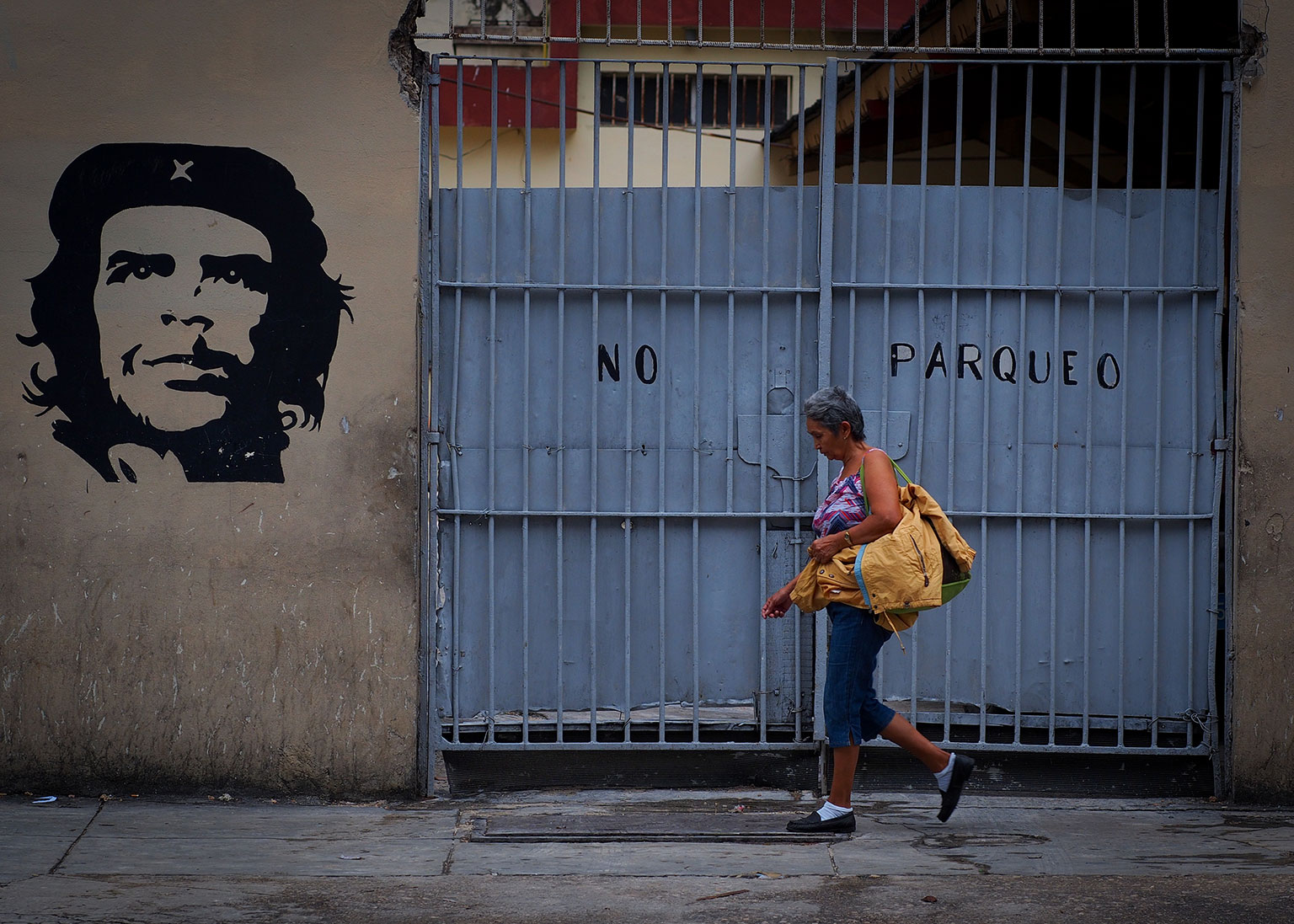 Cuba’s most iconic face, Ernesto “Che” Guevara is credited with transforming education on the island. Literacy rates soared from an estimated 60–77 percent before the revolution to 96 percent two years after.
Cuba’s most iconic face, Ernesto “Che” Guevara is credited with transforming education on the island. Literacy rates soared from an estimated 60–77 percent before the revolution to 96 percent two years after.For a decade I’ve been told to “visit Cuba before it changes”—before Fidel dies or before the economic embargo is taken down. Because after then, the Cuba that tourists have known and loved for fifty years will disappear. For centuries Cuba has fought outside forces: Spanish colonization, American pressure, further isolation after the Soviet Union dissolved. But now Cuba is facing an internal struggle that could divide a country that has followed a single socio-economic direction for half a century—with a proven example of revolution in its past.
The change that we’ve been expecting won’t come with the collapse of a wall and an instant flood of American businesses. It’s Cuban businesses that are redefining the country. Whether embraced by the casa particular owner or rejected by the tobacco farmer, Cuba has already changed—not by foreign hands but by progressive adjustments to restrictive policies that have come from within. The classic cars are still running, the colonial buildings are being restored rather than torn down, and there are only a few cranes on the Havana skyline—but Cuba is a radically different country than it was even a few years ago, despite the embargo at least symbolically holding firm. The change lies in a growing economic disparity between those on the take—those with access to CUCs through tourism—and those who are, and may always be, living in a world of CUPs.
During my last afternoon in Viñales, I sit in the town square watching the same group of women wait for the tourists from Havana to arrive. The women are chatting and laughing, but when the bus appears down the road, they jostle for best position before the door opens. With hundreds of casas in town, competition is fierce—but a small few have realized that you either get out and hustle, or remain where you are.
I’m watching them work the crowd—“beautiful valley views,” “home cooking,” “very peaceful and quiet”—when a man on a moped pulls up and parks in front of the bus. Something about his vehicle looks wrong: the gas tank is missing. Instead, he has wired a two-litre pop bottle, half full of yellowish fuel, upside down between the handlebars. A thin rubber tube connects bottlecap to carburetor.
However Cuba’s future unfolds, the country will—as it always has—adapt.



